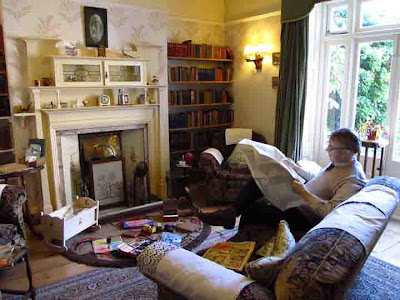 |
| "Uh, James, could you pass the Sports section?" |
Until a few years ago, when circumstances forced me to give
it up, I was an avid woodworker. I even
worked on my own chair, sweating blood (and yes, occasionally shedding it) over
mortise-and-tenon joints, and cutting the precise widths and lengths necessary
for each individual piece of the structure.
I’ve yet to finish that chair, but the process of building it gave me
a real appreciation for craftsmen who design and make their own
furniture.
While the characters and stories in the TV show “All
Creatures Great and Small” prompted me to buy the series on DVD, one thing that
caught my eye during repeat viewings was the sideboard in the great room. I’m not well versed in styles and periods,
but the lines of that particular piece of furniture captivated me. You never get a really good view of it--the
camera’s focus is quite rightly on the actors, and the dining table and chairs
huddle nearby—yet to me it possesses a beauty and character I’ve never seen
before.
 |
| Two nice sideboards, but not what I'm after. |
In touring The World
of James Herriot, one of the first rooms you see is the great room where
Siegfried, Tristan, James, Helen, and later, the Herriot children, would have
eaten meals, met with visitors, and relaxed.
Two sideboards hug one wall of the room.
While they possess their own individual character and beauty, neither
was the one seen in the show. Perhaps
these ones were the real ones James and the others used, or they may be typical
period furniture that the museum acquired.
At any rate, they weren’t the piece that I wanted to see.
 |
| Could this be the one? |
In the studio mockup, I entered the dining room set with
high expectations. Yet the sideboard
there seemed wrong: the wood too dark, and the lines different. In looking at the photograph now, I wonder:
might this be the piece used in the TV show?
Somehow, in the picture, it reminds me of the image in my mind that I
had sought. Perhaps it was. If there was one truth that the studio area
reinforced, it is how different people and things look on film. (If you don’t believe me, have a photo taken
of yourself, then compare it to what you see in the mirror). At any rate, no card or sign listed details
about the sideboard as to maker, style, or the type of wood used. One thing’s for sure: it certainly didn’t
bear the signature style of Robert Thompson, the famous Mouseman of
Kilburn. But more on that in tomorrow’s
post.
If anyone recognizes the style of the studio sideboard,
please let me know. In lieu of answers,
the search continues.
Captivated by beautiful furniture,
Dragon Dave
Related Dragon Cache entries

No comments:
Post a Comment